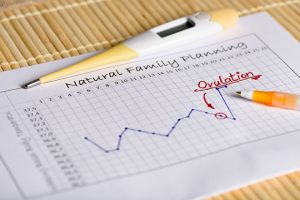Ovulation Calculator
Calculating the time you are ovulating can help you identify when you are most fertile and increase your chances of falling pregnant. So, what is ovulation, and when does it happen. Plus, how can you use our helpful ovulation calculator
What does ovulation mean?
Ovulation is the releasing of a mature egg from one of your ovaries. Once released, the egg travels down your fallopian tube to your uterus. If all goes well, along the way, it meets the sperm destined to fertilise it and will implant in your uterus to begin a pregnancy.

However, just like every great date, it is all about timing. Sperm can live inside your body for approximately five days but are in their prime in the first 12-24 hours. So for the best chance to fall pregnant, you need sperm to meet up with the egg as soon as possible after ovulation.
Having sex in the days leading up to ovulation and on the day you ovulate can increase the chance of sperm being in the right place at the right time. Therefore, knowing when you are likely to ovulate increases your chances of getting pregnant.
Learn more about how the ovulation cycle works.
How does the ovulation calculator work?
PBB’s calculator is simple – enter the first day of your last menstrual period and the average number of days for your menstrual cycle. The calculator will then estimate the date when you are likely to ovulate.

Please enter the first day of your last period and your average length menstrual cycle to calculate your approximate ovulation period.
In a normal menstrual cycle, ovulation is predictable, so if you know how long your menstrual cycle is, you can predict when ovulation will occur. Using your average menstrual cycle length and the date of your last period, our ovulation calculator will determine when you are most likely to ovulate. You are then provided with a window of around five days during which you are most fertile.
This information lets you know the best time to have sex if you are trying to fall pregnant. The ovulation calculator even estimates your approximate due date if you are successful!
Learn more about planning for pregnancy.
How do you track ovulation?
When we talk about menstrual cycles and ovulation, we use the first day of your period as “Day 1”. In a 28-day cycle, it was once thought ovulation occurred about 14 days before you got your period.
However, research has shown that fertility is far more complex. Ovulation can occur anywhere from day six in your cycle to around day 21.
But what if your cycle isn’t 28 days long? What then? You’re not alone. In reality, only about 13% of women have 28-day cycles. However, irrespective of your regular cycle length, ovulation can still be predicted, which is where the fertile window of opportunity comes in. By calculating the most fertile days in your cycle, our ovulation calculator removes a lot of guesswork about when you are most fertile.
What happens during ovulation
To understand ovulation, we need to go back to Day 1. Your menstrual cycle starts with the first day of bleeding during your period. When it comes to hormones, the star of the menstrual cycle show is follicle-stimulating hormone (FSH).
FSH’s first job is to prepare the eggs inside your ovaries for ovulation. We can think of the eggs in your ovaries like apples ripening on a tree. Several grow at once, but they don’t all ripen at precisely the same time. So when you go to the tree to pick one, you are looking for that perfectly ripe one.
Like the apple scenario, several eggs grow in your ovaries, but only one is released typically. At the moment of ovulation, the brain releases a surge of a hormone called luteinising hormone (LH), which triggers the release of the ripest (or most mature) egg. A tiny rupture occurs in the ovary wall, and the egg is swept into the fallopian tube by little, waving finger-like structures (fimbriae). Ovulation has occurred, and the egg’s journey to find a sperm has begun!
Learn more about how the ovulation cycle works.
Ovulation FAQs
When am I the most fertile?
When deciding the best days to have sex, your most fertile days are the ones right before you ovulate because the egg only survives for 24 hours after ovulation, so ideally, you want sperm ready and waiting for the egg to appear. However, if you have sex during the few days leading up to ovulation, you stand the best chance of the sperm being on time to meet your egg!

What is the difference between ovulation and fertile days?
Ovulation is when an egg is released from the ovary into the fallopian tube. Your fertile days are the days leading up to ovulation, the day of ovulation, and the 24 hours after ovulation – approximately five days in total.
How many days after ovulation does your period start?
Typically, the length between ovulation and the first day of your period is around 12 to 16 days. While menstrual cycles vary in length, this variance of days tends to occur in the first part of your cycle – the number of days before ovulation.
What is the best day to get pregnant during ovulation?
There isn’t a “best” day to get pregnant during ovulation. However, knowing when you ovulate and your most fertile days helps give you the best chances of getting pregnant.
What is the difference between ovulation and a period?
Your period, or menstruation, is the process of the body shedding the lining created in the uterus to support pregnancy. If there is no pregnancy, the lining is discarded in the form of your period flow. Ovulation is the body triggering the release of an egg from a woman’s ovary in preparation for fertilisation by a sperm.
How to tell if you are ovulating?
Definitively, the only way to know you are ovulating is with a blood test, which measures your hormone level. However, we know there are tell-tail physical symptoms that can help you spot ovulation. For example, tracking your basal body temperature (BBT), makes it possible to see a slight drop in temperature before ovulation and a small rise after ovulation. In addition, cervical mucus also becomes clear, slippery and stretchy at this time– like raw egg white. Plus, some women may experience tender breasts, mild abdominal pain or spotting during ovulation.
Basal body temperature
The basal body temperature (BBT) is the lowest temperature your body reaches during rest, that is, sleep. Before your ovary releases an egg, there is a sudden small drop in your BBT. After ovulation, there is a rise in your BBT that lasts for several days.
Therefore, if you take your BBT every morning, you can, over time, use these temperature changes to help pinpoint ovulation. BBT is usually taken first thing in the morning, immediately after waking up, and before getting out of bed.
Cervical Mucus
Cervical mucus is the natural vaginal discharge you see in your underwear or when wiping after the toilet. In response to your changing hormones, you will notice cervical mucus changes in colour and texture during your menstrual cycle.
Cervical mucus becomes clear, slippery and stretchy around ovulation when placed between your thumb and index finger – a bit like raw egg white. This texture is designed to help sperm move through the vagina and cervix and indicates ovulation.
Breast and abdominal tenderness and spotting
While not experienced by all women, breast tenderness can be caused by the changing hormone levels occurring during ovulation. Similarly, some women feel a dull ache, like mild period cramps around the time of ovulation. You may also notice a small amount of spotting around ovulation.
Changes in the cervix
Around the time of ovulation, your body tries to create an “all systems go” environment for conception, including a welcoming front door for sperm! At this time, the cervix becomes soft, high, open and wet (SHOW), ready for sperm to enter and help them do so. After ovulation, the reverse is true with the cervix as it becomes firm, low, closed and dry.
It can be tricky to know what you are looking for, certainly more complicated than looking for the other physical signs. However, if you want to give it a go, start by feeling your cervix daily. Whatever position you use to insert a tampon is often a good position. Then, using your index and middle finger, you can gently feel your cervix. Does it feel firm or soft? Wet or dry? High or low? With practice, you can know how your cervix changes around ovulation.
Ovulation Calculator page was updated 20th February 2022

 Wish List
Wish List